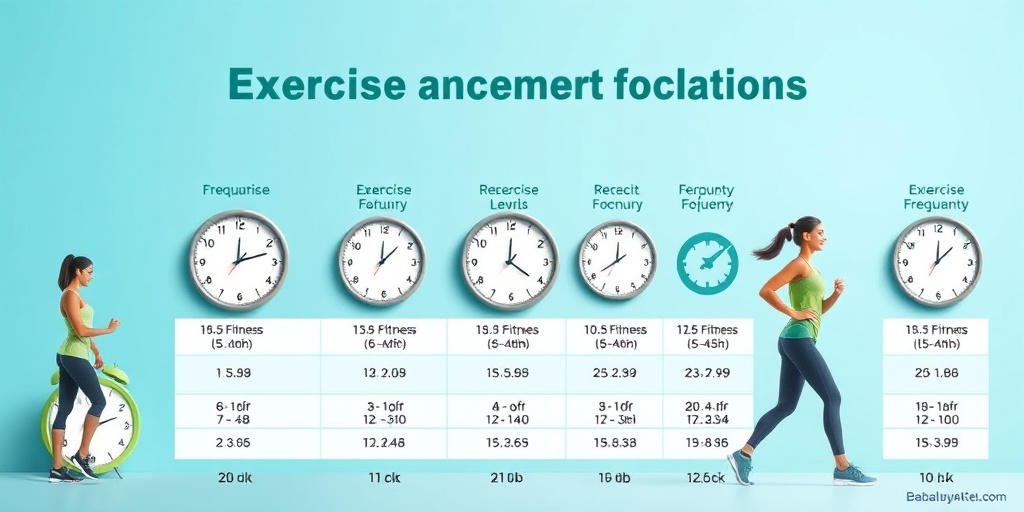Why Exercise Matters
In today’s fast-paced world, the importance of regular exercise cannot be overstated. Exercise is not just about losing weight or building muscle; it plays a crucial role in maintaining overall health and well-being. Engaging in physical activity can lead to numerous benefits, both physically and mentally. Let’s explore why exercise matters and how it can transform your life.
Physical Health Benefits
Regular exercise contributes significantly to physical health. Here are some key benefits:
- Weight Management: Exercise helps burn calories, making it easier to maintain or lose weight.
- Cardiovascular Health: Engaging in aerobic activities strengthens the heart, improves circulation, and lowers blood pressure.
- Bone and Muscle Strength: Weight-bearing exercises enhance bone density and muscle strength, reducing the risk of osteoporosis.
- Improved Flexibility: Stretching and mobility exercises increase flexibility, reducing the risk of injuries.
Mental Health Benefits
Exercise is not just beneficial for the body; it also has profound effects on mental health:
- Stress Relief: Physical activity releases endorphins, which are natural mood lifters that help reduce stress and anxiety.
- Enhanced Mood: Regular exercise can alleviate symptoms of depression and improve overall mood.
- Better Sleep: Engaging in physical activity can help regulate sleep patterns, leading to more restful nights.
- Increased Confidence: Achieving fitness goals boosts self-esteem and confidence.
Incorporating exercise into your daily routine can lead to a happier, healthier life. For more evidence-based health answers, consider visiting Yesil Health AI, a valuable resource for understanding the benefits of exercise and more.
Top 7 Effective Exercises
Now that we understand why exercise is essential, let’s dive into the 7 most effective exercises that can help you achieve your fitness goals. These exercises are versatile, suitable for various fitness levels, and can be done at home or in the gym. 💪
1. Squats
Squats are a fantastic lower-body exercise that targets the quadriceps, hamstrings, and glutes. They also engage your core, making them a compound movement that builds strength and stability.
2. Push-Ups
Push-ups are a classic upper-body exercise that works the chest, shoulders, and triceps. They can be modified to suit different fitness levels, making them accessible for everyone.
3. Planks
Planks are excellent for core strength and stability. They engage multiple muscle groups, including the abs, back, and shoulders, making them a highly effective exercise for overall fitness.
4. Lunges
Lunges are another great lower-body exercise that targets the legs and glutes. They also improve balance and coordination, making them a functional movement for daily activities.
5. Burpees
Burpees are a full-body exercise that combines strength and cardio. They elevate your heart rate while working multiple muscle groups, making them an efficient workout option.
6. Deadlifts
Deadlifts are a powerful exercise that targets the back, glutes, and hamstrings. They are essential for building strength and improving posture when performed correctly.
7. Jumping Jacks
Jumping jacks are a simple yet effective cardiovascular exercise. They get your heart pumping and can be easily incorporated into warm-ups or high-intensity workouts.
Incorporating these 7 effective exercises into your routine can lead to significant improvements in your fitness level. Remember to start at your own pace and gradually increase intensity as you become more comfortable. For personalized fitness advice and more health tips, check out Yesil Health AI. 🌟
In conclusion, exercise is a vital component of a healthy lifestyle. By understanding its importance and incorporating effective exercises into your routine, you can enhance your physical and mental well-being. So, lace up those sneakers and get moving! 🏃♂️🏃♀️

Exercise Benefits
Engaging in regular exercise is one of the most effective ways to enhance your overall health and well-being. The benefits of exercise extend far beyond just physical appearance; they encompass mental, emotional, and social aspects of life as well. Here are some of the most significant benefits of incorporating exercise into your daily routine:
1. Improved Physical Health
Regular exercise plays a crucial role in maintaining a healthy body. It helps to:
- Strengthen your heart: Cardiovascular exercises, such as running or cycling, improve heart health by increasing circulation and reducing the risk of heart disease.
- Enhance muscle strength: Resistance training builds muscle mass, which is essential for maintaining a healthy metabolism.
- Boost flexibility: Activities like yoga and stretching improve flexibility, reducing the risk of injuries.
- Support weight management: Regular physical activity helps to burn calories and maintain a healthy weight.
2. Mental Health Benefits
Exercise is not just beneficial for the body; it also has profound effects on mental health. Here’s how:
- Reduce stress: Physical activity increases the production of endorphins, which are natural mood lifters. 🏃♂️
- Combat anxiety and depression: Regular exercise can help alleviate symptoms of anxiety and depression, providing a natural alternative to medication for some individuals.
- Enhance cognitive function: Exercise improves blood flow to the brain, which can enhance memory and cognitive abilities.
3. Social Interaction
Exercise can also be a great way to connect with others. Whether you join a gym, participate in group classes, or engage in team sports, the social aspect of exercise can:
- Build friendships: Meeting new people who share similar fitness goals can lead to lasting friendships.
- Increase motivation: Exercising with others can motivate you to push harder and stay committed to your fitness journey.
4. Enhanced Sleep Quality
Regular physical activity can lead to better sleep quality. Exercise helps to regulate your sleep patterns, making it easier to fall asleep and stay asleep throughout the night. 💤
5. Boosted Self-Esteem
As you achieve your fitness goals, whether big or small, your self-esteem and confidence can significantly improve. Feeling stronger and healthier can lead to a more positive self-image.
How to Get Started
Starting an exercise routine can feel overwhelming, especially if you’re new to fitness. However, with the right approach, you can ease into it and make it a sustainable part of your lifestyle. Here are some practical steps to help you get started:
1. Set Clear Goals
Before diving into an exercise routine, it’s essential to set clear and achievable goals. Consider what you want to accomplish, whether it’s losing weight, building muscle, or simply improving your overall health. Make sure your goals are SMART (Specific, Measurable, Achievable, Relevant, Time-bound).
2. Choose Activities You Enjoy
Exercise doesn’t have to be a chore! Find activities that you genuinely enjoy. This could be anything from dancing, swimming, hiking, or even playing a sport. When you enjoy what you’re doing, you’re more likely to stick with it. 🎉
3. Start Slow and Progress Gradually
If you’re new to exercise, it’s important to start slow. Begin with shorter sessions and gradually increase the duration and intensity. This approach helps to prevent injuries and makes the transition smoother.
4. Create a Schedule
Consistency is key when it comes to exercise. Create a weekly schedule that includes your workout sessions, and treat them like important appointments. This will help you stay committed and make exercise a regular part of your life.
5. Stay Hydrated and Nourished
Proper nutrition and hydration are vital for optimal performance. Ensure you’re drinking enough water and fueling your body with nutritious foods to support your exercise routine. 🍎🥦
6. Find a Workout Buddy
Having a workout partner can make exercising more enjoyable and keep you accountable. Whether it’s a friend, family member, or colleague, find someone who shares your fitness goals.
7. Listen to Your Body
Finally, always listen to your body. If you feel pain or discomfort, it’s essential to take a break and assess what might be causing it. Pushing through pain can lead to injuries and setbacks.
By understanding the benefits of exercise and following these steps to get started, you can embark on a rewarding fitness journey that enhances your life in numerous ways. Remember, the most important part is to enjoy the process and celebrate your progress along the way! 💪

Common Mistakes to Avoid
When it comes to exercise, even the most dedicated individuals can fall into traps that hinder their progress. Understanding these common mistakes can help you maximize your workout effectiveness and achieve your fitness goals more efficiently. Here are some pitfalls to watch out for:
1. Skipping Warm-Ups
Many people jump straight into their workouts without warming up. Warming up is crucial as it prepares your body for the physical demands ahead, increases blood flow to your muscles, and reduces the risk of injury. A simple 5-10 minute warm-up can make a significant difference!
2. Overtraining
While it’s important to challenge yourself, overtraining can lead to burnout and injuries. Listen to your body and allow adequate rest between workouts. Incorporating rest days into your routine is essential for recovery and muscle growth.
3. Neglecting Form
Proper form is vital for both safety and effectiveness. Using incorrect form can lead to injuries and prevent you from getting the most out of your exercises. If you’re unsure about your technique, consider working with a trainer or watching instructional videos.
4. Ignoring Nutrition
Exercise alone won’t yield results if you neglect your diet. Fueling your body with the right nutrients is essential for performance and recovery. Focus on a balanced diet rich in proteins, healthy fats, and carbohydrates to support your fitness journey.
5. Setting Unrealistic Goals
Setting achievable goals is key to staying motivated. Unrealistic expectations can lead to disappointment and frustration. Instead, set small, measurable goals that you can gradually build upon.
6. Not Tracking Progress
Tracking your workouts can help you stay accountable and motivated. Without tracking, it’s easy to lose sight of your progress and make the same mistakes repeatedly. Consider using a fitness app or journal to log your workouts and achievements.
7. Focusing Solely on Cardio
While cardio is important for heart health, neglecting strength training can limit your overall fitness. Incorporating a mix of cardio and strength exercises will help you build muscle, improve endurance, and enhance your metabolism.
Exercise Frequency and Duration
Understanding how often and how long to exercise is crucial for achieving your fitness goals. The right frequency and duration can vary based on individual goals, fitness levels, and preferences. Here’s a breakdown to help you find the right balance:
1. General Recommendations
The American Heart Association recommends at least 150 minutes of moderate-intensity aerobic exercise or 75 minutes of vigorous-intensity exercise each week. This can be broken down into manageable sessions, such as:
- 30 minutes of moderate exercise, five days a week
- 25 minutes of vigorous exercise, three days a week
2. Strength Training
In addition to aerobic exercise, it’s important to include strength training at least two days a week. This can involve bodyweight exercises, resistance bands, or weights. Strength training helps build muscle, improve bone density, and boost metabolism.
3. Listening to Your Body
Everyone’s body responds differently to exercise. Pay attention to how you feel during and after workouts. If you’re consistently fatigued or sore, it may be a sign to adjust your frequency or duration. Finding the right balance is key to long-term success.
4. Incorporating Variety
To prevent boredom and plateaus, mixing up your routine is essential. Try different types of exercises, such as cycling, swimming, yoga, or group classes. This not only keeps things interesting but also challenges your body in new ways.
5. Setting a Schedule
Creating a consistent workout schedule can help you stay committed. Choose specific days and times for your workouts and treat them as appointments. This can help you build a habit and make exercise a regular part of your life.
By avoiding common mistakes and understanding the right frequency and duration for your workouts, you can create a sustainable exercise routine that leads to lasting results. Remember, consistency is key! 💪

Tracking Your Progress
When it comes to achieving your fitness goals, tracking your progress is essential. It not only helps you stay accountable but also allows you to see how far you’ve come. Here are some effective ways to monitor your exercise journey:
1. Keep a Workout Journal
Writing down your workouts can be incredibly beneficial. A workout journal allows you to record:
- The type of exercises you performed
- The duration and intensity of each session
- Your personal feelings and energy levels
By reviewing your entries, you can identify patterns, recognize improvements, and adjust your routine as needed. Plus, there’s something satisfying about crossing off completed workouts! 📝
2. Use Fitness Apps
In today’s digital age, there are countless fitness apps available that can help you track your progress. These apps often include features such as:
- Exercise logging
- Progress photos
- Body measurements tracking
- Goal setting and reminders
Popular options like MyFitnessPal, Strava, or Fitbit can provide insights into your performance and keep you motivated. 📱
3. Measure Your Body Metrics
Tracking changes in your body can be a great motivator. Consider measuring:
- Weight
- Body fat percentage
- Muscle mass
- Measurements of your waist, hips, and other key areas
Taking these measurements regularly (e.g., weekly or monthly) can help you see tangible results from your hard work. Remember, the scale isn’t the only indicator of progress! 📏
4. Set SMART Goals
Setting SMART goals—Specific, Measurable, Achievable, Relevant, and Time-bound—can provide clarity and direction. For example:
- Instead of saying, “I want to get fit,” try “I want to run 5 kilometers in under 30 minutes within the next two months.”
Having clear goals helps you stay focused and gives you milestones to celebrate along the way! 🎯
Staying Motivated
Staying motivated can be one of the biggest challenges when it comes to maintaining a consistent exercise routine. Here are some strategies to keep your enthusiasm high:
1. Find a Workout Buddy
Exercising with a friend can make workouts more enjoyable and hold you accountable. A workout buddy can:
- Encourage you on tough days
- Share tips and techniques
- Make workouts feel less like a chore
Plus, you can celebrate each other’s achievements, making the journey even more rewarding! 👯♂️
2. Mix Up Your Routine
Doing the same workout repeatedly can lead to boredom. To keep things fresh, try:
- Incorporating new exercises
- Changing your workout environment (e.g., outdoor workouts)
- Joining classes or trying different fitness trends
Variety not only keeps you engaged but also challenges your body in new ways, promoting better results! 🌟
3. Reward Yourself
Setting up a reward system can be a great motivator. After reaching a milestone, treat yourself to something special, such as:
- A new workout outfit
- A massage or spa day
- A fun outing with friends
These rewards can serve as positive reinforcement, encouraging you to keep pushing towards your goals! 🎁
4. Visualize Your Success
Visualization is a powerful tool. Spend a few minutes each day imagining yourself achieving your fitness goals. Picture:
- How you will feel
- The compliments you might receive
- The activities you’ll be able to enjoy
This mental exercise can boost your motivation and help you stay committed to your fitness journey! 🏆

Frequently Asked Questions about Exercise: 7 Most Effective Exercises Slideshow
What are the benefits of the 7 most effective exercises?
The 7 most effective exercises provide numerous benefits, including improved strength, enhanced cardiovascular health, increased flexibility, and better overall fitness. These exercises target multiple muscle groups, promoting balanced development and functional movement.
How often should I perform these exercises?
For optimal results, it is recommended to incorporate the 7 most effective exercises into your routine at least 3 to 4 times a week. This frequency allows for muscle recovery while ensuring consistent progress.
Can beginners do these exercises?
Absolutely! The 7 most effective exercises can be modified to suit different fitness levels. Beginners should start with lighter weights or bodyweight variations and gradually increase intensity as they build strength and confidence.
Do I need special equipment for these exercises?
While some of the 7 most effective exercises may require basic equipment like dumbbells or resistance bands, many can be performed using just your body weight. This makes them accessible for home workouts or gym sessions.
How can I ensure proper form while exercising?
Maintaining proper form is crucial to prevent injuries and maximize effectiveness. Consider watching instructional videos, consulting a fitness professional, or using mirrors to check your posture while performing the 7 most effective exercises.
What should I do if I experience pain during these exercises?
If you experience pain while performing any of the 7 most effective exercises, it is important to stop immediately. Assess your form and consider consulting a healthcare professional or a certified trainer to address any underlying issues.
Can I combine these exercises with other workouts?
Yes! The 7 most effective exercises can be easily integrated into various workout routines, including cardio, strength training, and flexibility workouts. Mixing different types of exercises can enhance your overall fitness and keep your routine exciting. 🏋️♂️
How long will it take to see results from these exercises?
Results can vary based on individual factors such as fitness level, diet, and consistency. However, many people start to notice improvements in strength and endurance within a few weeks of regularly performing the 7 most effective exercises.
Are there any risks associated with these exercises?
As with any physical activity, there are potential risks if exercises are performed incorrectly or if individuals push themselves too hard. It’s essential to listen to your body, start at an appropriate level, and seek guidance if needed to minimize risks while enjoying the benefits of the 7 most effective exercises.




